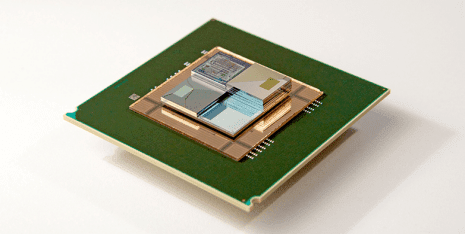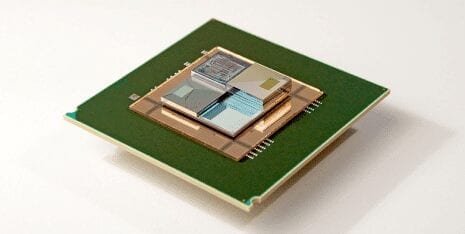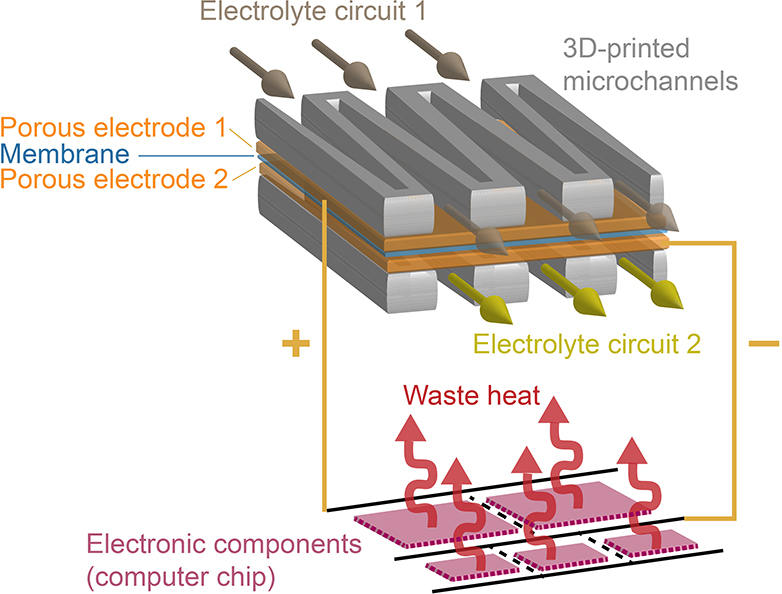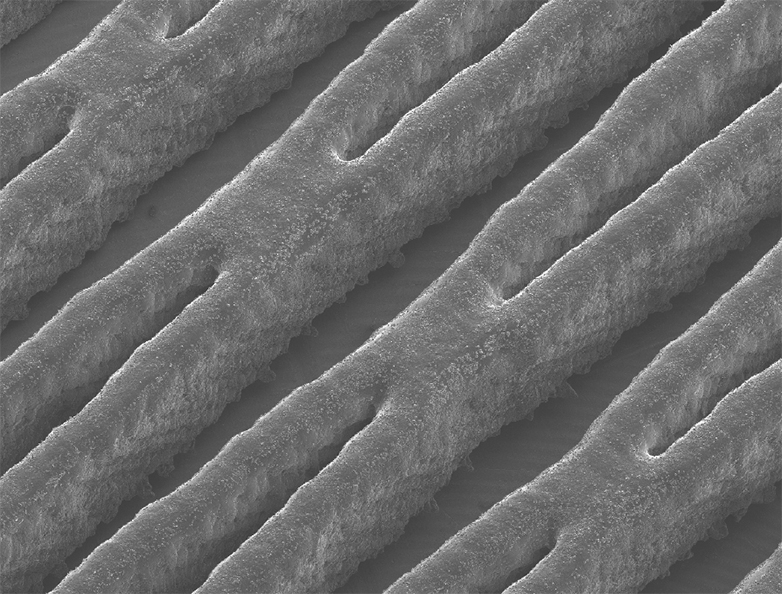
In the future, a new type of tiny redox flow battery will supply tightly packed electronic components with energy, while also dissipating the heat they produce.
Researchers at ETH Zurich and IBM Research Zurich have built a tiny redox flow battery. This means that future computer chip stacks – in which individual chips are stacked like pancakes to save space and energy – could be supplied with electrical power and cooled at the same time by such integrated flow batteries. In a flow battery, an electrochemical reaction is used to produce electricity out of two liquid electrolytes, which are pumped to the battery cell from outside via a closed electrolyte loop.
“The chips are effectively operated with a liquid fuel and produce their own electricity,” says Dimos Poulikakos, Professor of Thermodynamics at ETH Zurich. As the scientists use two liquids that are known to be suitable both as flow-battery electrolytes and as a medium to also effect cooling, excess heat can also be dissipated from the chip stack via the same circuit.
The battery built by the scientists is only around 1.5 millimetres thick. The idea would be to assemble chip stacks layer by layer: a computer chip, then a thin battery micro-cell that supplies the chip with electricity and cools it, followed by the next computer chip and so on.
Record-high output
Previous flow batteries (see box) are usually large scale and used mainly in stationary energy storage applications, for instance in combination with wind farms and solar power plants, where they temporarily store the energy produced there so it can be used at a later time. “We are the first scientists to build such a small flow battery so as to combine energy supply and cooling,” says Julian Marschewski, a doctoral student in Poulikakos’ group.
The output of the new micro-battery also reaches a record-high in terms of its size: 1.4 watts per square centimetre of battery surface. Even if you subtract the power required to pump the liquid electrolytes to the battery, the resulting net power density is still 1 watt per square centimetre.
As the researchers were able to show in an experiment, the electrolyte liquids are actually able to cool a chip. They are even able to dissipate heat amounts many times over what the battery generates as electrical energy (which is converted into heat while the chip is in operation).
Channel system optimised with 3D printing
According to the scientists, the most serious challenge in constructing the new micro-flow batteries was to build them in such a way that they are supplied with electrolytes as efficiently as possible while at the same time keeping the pumping power as low as possible. “It was important to find the ideal compromise,” says Marschewski.
The electrochemical reactions in the battery occur in two thin and porous electrode layers that are separated by a membrane. Marschewski and his colleagues used 3D-printing technology to build a polymer channel system to press the electrolyte liquid into the porous electrode layer as efficiently as possible. The most suitable of the various designs tested proved to be one made of wedge-shaped convergent channels.
Interesting for large systems, too
The scientists have now provided an initial proof-of-concept for the construction of a small flow battery. Although the power density of the new micro-flow battery is very high, the electricity produced is still not entirely sufficient to operate a computer chip. In order for the flow battery to be used in a chip stack, it must be further optimised by industry partners.
As the scientists point out, the new approach is also interesting for other applications: in lasers, for example, which have to be supplied with energy and cooled; or for solar cells, where the electricity produced could be stored directly in the battery cell and used later when needed. The system could also keep the operating temperature of the solar cell at the ideal level. In addition, large flow batteries could also be improved with the optimised approach of forcing the electrolyte liquids through the porous electrodes.
Learn more: Liquid fuel for future computers
[osd_subscribe categories=’redox-flow-battery’ placeholder=’Email Address’ button_text=’Subscribe Now for any new posts on the topic “REDOX FLOW BATTERY”‘]
Receive an email update when we add a new REDOX FLOW BATTERY article.
The Latest on: Redox flow battery
[google_news title=”” keyword=”redox flow battery” num_posts=”10″ blurb_length=”0″ show_thumb=”left”]
via Google News
The Latest on: Redox flow battery
- Disrupting Energy Storageon April 25, 2024 at 10:05 am
There’s a great deal of research taking place with battery technologies to find a viable alternative to lithium-ion (Li-ion) batteries, which will find its way to the power ...
- IDTechEx Discusses Future Market Penetration of the Redox Flow Batteryon April 25, 2024 at 6:35 am
The evolution of the redox flow battery over several decades has seen various chemistries being developed, commercialized, or even abandoned due to factors such as poor electrochemical reversibility ...
- IDTechEx Discusses Future Market Penetration of the Redox Flow Batteryon April 25, 2024 at 5:01 am
BOSTON, April 25, 2024 /PRNewswire/ -- The evolution of the redox flow battery over several decades has seen various chemistries being developed, commercialized, or even abandoned due to factors ...
- Going with the flow: Research dives into electrodes on energy storage batterieson April 24, 2024 at 9:54 am
As a grid-scale energy storage system, flow batteries have gained increasing attention as a means to address the challenges associated with fluctuations and intermittency in renewable energy sources.
- Vanadium Redox Flow Batterieson April 1, 2024 at 5:00 pm
As renewable energy capacity increases on power grids, battery energy storage systems become more and more important. While lead battery technology is not new, it is evolving. Advanced lead ...
- Scientists reveal new flow battery tech based on common chemicalon March 25, 2024 at 11:38 am
At the center of the design is a lab-scale, iron-based flow battery with unparalleled cycling stability. According to a statement, the battery “exhibited remarkable cycling stability over one thousand ...
- Guide to Solar Batteries: Are They Worth It? (April 2024)on March 29, 2023 at 2:53 pm
Some common chemistries used by solar batteries are lead-acid, lithium-ion, nickel-cadmium and redox flow. When comparing solar batteries, you should consider both the rated power output ...
- New Redox Flow Lithium Battery May be Ideal for Large-Scale Energy Storage (1 of 1) (IMAGE)on August 20, 2022 at 9:56 pm
The concept of a redox flow lithium battery full cell: schematic illustration of a redox flow lithium battery (RFLB) full cell (top panel) and photograph of an RFLB full cell stack (bottom panel).
- redox flow batterieson April 5, 2022 at 5:00 pm
Today’s battery-powered gadgets are an obvious example of such time-shifting, but energy storage plays a major role on the grid itself, too, whether in electrochemical, mechanical or in some ...
via Bing News













